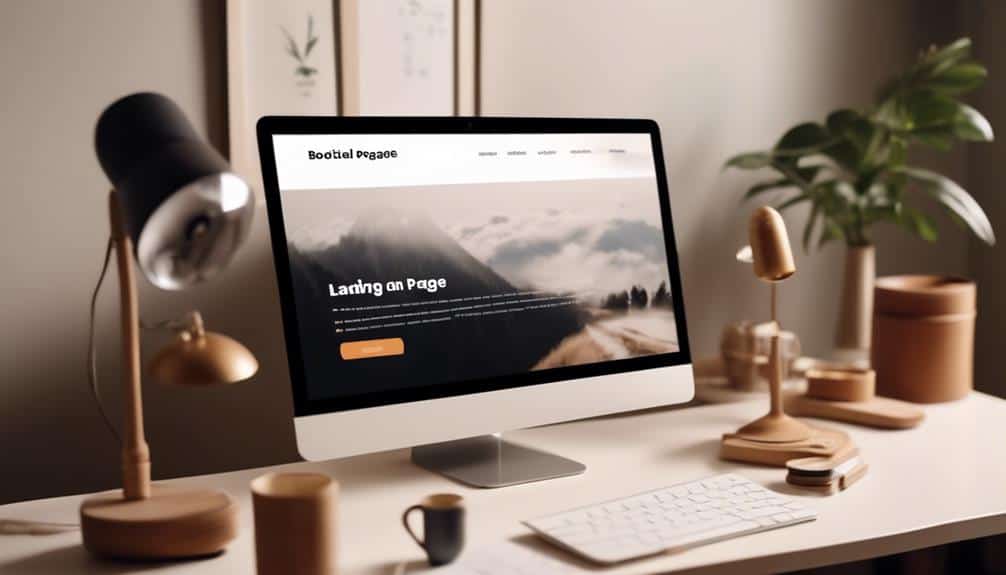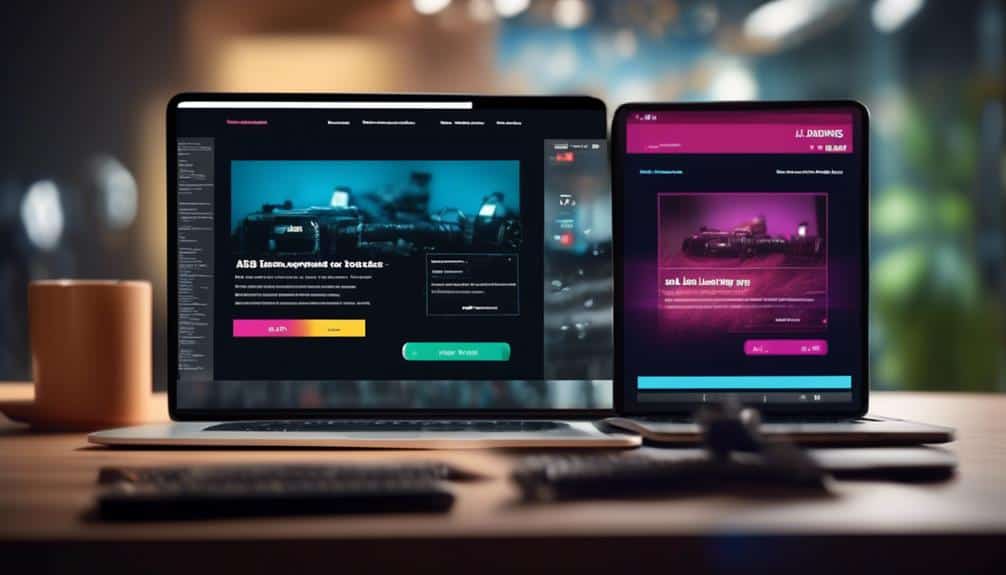From Click to Customer: Building Landing Pages That Drive Action
Are you tired of landing pages that seem to be more like dead ends than pathways to customer engagement?
It's time to revolutionize your approach and transform those mere clicks into valuable conversions.
By mastering the art of creating landing pages that not only attract but also drive action, you can elevate your digital presence to new heights.
Stay tuned to discover the essential strategies that will empower you to build high-converting landing pages that truly resonate with your audience and lead to tangible results.
Key Takeaways
- Craft compelling headlines and use persuasive language for action to capture attention and drive engagement.
- Design for user experience by focusing on intuitive elements, clear visual hierarchy, and streamlined navigation to optimize conversion rates.
- Experiment with call-to-action button colors, placements, and messaging to enhance user engagement and drive conversions effectively.
- Prioritize mobile responsiveness and performance optimization to cater to the increasing number of mobile users and capitalize on higher conversion rates from mobile traffic.
Understanding Landing Page Basics

To create high-converting landing pages, it's crucial to grasp the fundamental principles that underpin their effectiveness. Understanding landing page basics is key to optimizing conversion rates and driving actions. Landing page optimization involves strategic design elements that guide visitors towards a specific goal, whether it's making a purchase, signing up for a service, or downloading content.
Data-driven decisions are essential in maximizing conversion rates. By analyzing user behavior, A/B testing different variations, and tracking key metrics, you can continuously refine your landing pages for better performance. Innovating in this space means staying agile and adapting to the ever-changing digital landscape.
When it comes to landing page optimization, simplicity often reigns supreme. Clear and concise messaging, strategically placed call-to-action buttons, and compelling visuals can make a significant impact on conversion rates. Remember, every element on your landing page should serve a purpose and lead visitors towards taking action.
Crafting Compelling Headlines
Craft headlines that captivate your audience's attention and drive immediate engagement. Your headlines are the gateway to your landing page, the first touchpoint that can make or break a visitor's decision to explore further. By employing engaging copywriting techniques and incorporating emotional appeal, you can create headlines that not only grab attention but also resonate with your audience on a deeper level.
To craft compelling headlines, consider the following strategies:
| Strategy | Description | Example |
|---|---|---|
| Keep it concise | Capture the essence of your offer in a few impactful words | "Unlock Your Potential" |
| Evoke curiosity | Spark interest by hinting at the benefits without giving everything away | "Discover the Secret Now" |
| Use power words | Incorporate strong, persuasive language to compel action | "Transform Your Life Today" |
| Personalize the is | Address the reader directly to create a sense of connection | "Achieve Your Dreams with Us" |
Crafting headlines that combine these elements will not only attract visitors but also entice them to engage with your landing page further. Make every word count and watch as your conversion rates soar.
Designing for User Experience

To optimize your landing page for user experience, focus on a user-friendly layout that guides visitors seamlessly through your content.
Enhancing visual appeal with high-quality images and concise, impactful text can capture attention and encourage further engagement.
Streamlining the navigation experience ensures visitors can easily find what they're looking for, leading to increased interactions and conversions.
User-Friendly Layout Tips
Implementing intuitive navigation and clear visual hierarchy are key elements in creating user-friendly layouts that enhance the overall experience on your landing pages. When it comes to user-friendly design, understanding color psychology and font selection is crucial. Utilizing colors that evoke the right emotions and choosing fonts that are easy to read can significantly impact user engagement. Below is a table summarizing some key tips for creating a user-friendly layout on your landing pages:
| User-Friendly Layout Tips | Description |
|---|---|
| Color Psychology | Choose colors that resonate with your brand and evoke desired emotions. |
| Font Selection | Opt for readable fonts that enhance readability and visual appeal. |
| Clear Visual Hierarchy | Organize content in a logical order to guide users through the page efficiently. |
Enhancing Visual Appeal
Your landing page's user-friendly layout, with its emphasis on color psychology, font selection, and clear visual hierarchy, sets the foundation for enhancing visual appeal and optimizing user experience.
Utilizing color psychology strategically can evoke specific emotions in your visitors, influencing their perception and behavior. Bold, contrasting colors can draw attention to important elements like call-to-action buttons, guiding users towards conversion.
Additionally, establishing a clear visual hierarchy ensures that visitors can easily navigate your page, focusing on key information in a structured manner.
Enhance user engagement and streamline navigation by prioritizing intuitive design elements that guide visitors seamlessly through your landing page experience. Simplifying clicks is crucial for keeping users engaged. Implement clear call-to-action buttons that stand out and lead visitors to the next step.
Navigation efficiency is key; ensure that menus are easy to locate and understand. Use strategic placement of links and buttons to direct users to relevant sections without confusion. A clutter-free layout enhances user experience by reducing cognitive load. Incorporate visual cues such as arrows or progress indicators to assist users in moving through the page effortlessly.
Optimizing Call-to-Action Buttons

To increase conversion rates on your landing pages, strategically designing and testing your call-to-action buttons is crucial. Optimizing your call-to-action buttons can significantly impact user engagement and conversion rates.
Here are three key strategies to consider:
- Color Psychology: Experiment with different button colors to evoke specific emotions and guide user behavior. For instance, green buttons can convey trust and promote clicking, while red buttons can create a sense of urgency.
- Clear Messaging: Ensure your call-to-action buttons have concise and compelling text that clearly communicates the action users are expected to take. Use action-oriented words like 'Get Started,' 'Download Now,' or 'Subscribe.'
- Button Placement: Test different placements for your call-to-action buttons to determine the most effective location for driving conversions. Consider placing buttons prominently above the fold or at the end of engaging content.
Leveraging Social Proof
After optimizing your call-to-action buttons for maximum impact, harnessing the power of social proof can further enhance user trust and drive conversions on your landing pages. Trust signals such as testimonials and reviews provide potential customers with valuable insights into the positive experiences others have had with your product or service. By strategically placing these testimonials on your landing page, you can instill confidence in visitors and alleviate any doubts they may have.
Research shows that incorporating testimonials can increase conversion rates by up to 34%. When users see that others have benefited from what you offer, they're more likely to take the desired action. Additionally, displaying star ratings or numerical scores from review platforms can act as visual cues that reinforce the credibility of your business.
To maximize the impact of social proof, consider using customer quotes that highlight specific benefits or features of your offering. Ensure that the testimonials are authentic and relatable to your target audience to establish a deeper connection and build trust effectively. By leveraging social proof in a strategic manner, you can significantly boost the effectiveness of your landing pages and drive higher conversion rates.
Implementing A/B Testing

Optimizing your landing page through A/B testing allows you to scientifically evaluate different design elements and content variations to determine the most effective combination for driving conversions.
Here are three key strategies to consider when implementing A/B testing:
- Testing Headlines: Experiment with different headline variations to see which ones resonate best with your target audience. A compelling headline can significantly impact the conversion rate of your landing page.
- Analyzing Call-to-Action Buttons: Test different colors, text, and placements of your call-to-action buttons to determine which combination yields the highest conversion rates. Small changes in these elements can lead to significant improvements in your overall conversion rate.
- Utilizing Multivariate Testing: In addition to A/B testing, consider implementing multivariate testing to analyze multiple elements simultaneously. This advanced testing method can provide deeper insights into how different combinations of design elements and content affect your conversion rates.
Mobile Responsiveness Matters
Mobile responsiveness is crucial for maximizing user engagement and conversion rates on your landing page. With the increasing use of mobile devices, having a responsive layout that adapts seamlessly to different screen sizes is imperative for capturing and retaining your audience's attention. A well-thought-out mobile design can significantly impact user experience, leading to higher click-through rates and ultimately boosting your conversion metrics.
To emphasize the importance of mobile responsiveness, let's delve into some key statistics in the table below:
| Statistic | Percentage/Number |
|---|---|
| Mobile users worldwide | 5.22 billion |
| Percentage of web traffic from mobile | 53.3% |
| Mobile conversion rates | 64% higher than non-responsive sites |
| Average mobile bounce rate | 52% |
| Revenue from mobile e-commerce | $2.66 trillion |
These numbers underscore the critical role that mobile design and responsive layouts play in driving successful outcomes on your landing page. By prioritizing mobile responsiveness, you can create a user-centric experience that drives action and enhances your overall conversion rates.
Speed and Performance Optimization

You need to prioritize speed and performance optimization for your landing pages. Research shows that a one-second delay in page load time can result in a 7% reduction in conversions.
Load Time Importance
To maximize user engagement and conversions on your landing pages, prioritizing speed and performance optimization is imperative. When it comes to load time importance, every millisecond counts in capturing your audience's attention and driving them to take action.
Consider the following key points to ensure your website is optimized for peak performance:
- Optimize Images: Compress images without sacrificing quality to reduce load times.
- Minimize Redirects: Too many redirects can slow down the loading process significantly.
- Utilize Caching: Leverage browser caching to store frequently accessed data, speeding up subsequent visits.
Mobile-Friendly Design
For optimal speed and performance optimization on your landing pages, crafting a mobile-friendly design is crucial in capturing and retaining user interest. Mobile conversion rates are directly impacted by the responsiveness of your interface. Ensuring that your landing page is accessible and visually appealing across various devices is key to driving action. A responsive interface not only enhances user experience but also boosts conversions. Consider the following table to guide you in creating a mobile-friendly design that drives results:
| Optimization Strategy | Benefits |
|---|---|
| Implementing AMP | Faster load times, higher mobile conversions |
| Compressing Images | Improved page speed, reduced bounce rates |
| Minimizing Redirects | Enhanced user experience, increased conversion rates |
Analyzing Data for Continuous Improvement
Utilizing advanced analytics to uncover actionable insights is key to enhancing landing page performance and achieving continuous optimization. By delving into data, you can gain valuable information that will drive your conversion rates and improve user behavior on your landing pages.
Here are three crucial steps to help you analyze data effectively:
- Track User Interactions: Monitor user behavior on your landing pages to understand how visitors navigate through your content. Identify patterns that lead to conversions and areas where users may be dropping off.
- A/B Testing: Experiment with different elements on your landing pages and analyze the results. By comparing variations, you can determine what resonates best with your audience and optimize for higher conversion rates.
- Utilize Heatmaps: Heatmaps provide visual representations of where users are clicking and how far they scroll on your landing pages. This data can help you identify areas of interest and optimize your layout for better user engagement.
Frequently Asked Questions
How Can I Effectively Incorporate Interactive Elements Into My Landing Page Design to Engage Users?
To engage users effectively, incorporate interactive elements like gamification for engagement and animation for user interaction. Design with user experience in mind to boost engagement. Strategic integration of these elements will drive action on your landing page.
What Are Some Creative Ways to Personalize Landing Pages for Different Target Audiences?
To tailor your landing page for diverse audiences, personalize content based on demographics, behavior, and preferences. Use dynamic text, images, and interactive elements to engage visitors and guide them towards action. Enhance user experience with targeted messaging.
How Can I Ensure That My Landing Page Is Accessible to Individuals With Disabilities?
Ensure your landing page is accessible by incorporating accessibility tools and inclusive design. This not only caters to individuals with disabilities but also enhances user engagement and boosts conversion rates. Prioritize inclusivity for optimal results.
What Strategies Can I Use to Improve the Loading Speed of My Landing Page on Different Devices?
Improve your landing page loading speed on all devices by implementing image compression and caching. Optimize for responsiveness and use lazy loading. These strategies ensure a faster, more seamless user experience, boosting engagement and conversions.
Are There Any Advanced Techniques for Tracking and Analyzing User Behavior on My Landing Page for Better Optimization?
To enhance your landing page performance, dive deep into user behavior with heatmap analysis and scroll tracking. Conduct A/B testing to optimize conversions and fine-tune your conversion funnel. These advanced techniques provide valuable insights for better optimization.
Conclusion
You have the power to turn clicks into customers with effective landing pages. By focusing on crafting compelling headlines, designing for user experience, optimizing call-to-action buttons, leveraging social proof, implementing A/B testing, ensuring mobile responsiveness, and optimizing speed and performance, you can drive action and achieve your business goals.
Analyzing data for continuous improvement will further enhance your landing page strategy, leading to increased conversions and success. Keep refining and testing to see the results you desire.








